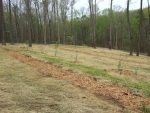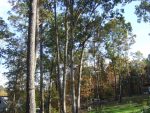Lessons Learned in Our Orchard
by C.D., Survival Blog:

Background: We bought our homestead in November, 2012. At the time we lived in the same area but in a neighborhood with protective covenants on a half acre lot. We found we weren’t able to do the things we needed and wanted to do in order to be resilient no matter what the economic or natural environment threw us. The property we moved to was about 5 acres with plenty of room to incorporate an orchard. I had pre-ordered a number of fruit trees and had prepared the ground to plant them in our old yard. They arrived after right before our move and we quickly needed to get them into the ground in our new property. We have learned many things in the seven years since we planted our first fruit trees. Our hope is that you may benefit from our mistakes and decide to grow a fruit tree or two — or many.
Our Homestead: Our homestead is located in a rural part of North Georgia. Agriculture and tourism are the main economic activities here. There are many orchards, vineyards, and broiler houses in the county. We are located in the foothills of the Appalachians which means lots of hardwoods and a shortage of level land. Water is abundant in rainfall, as well as the many rivers, streams and springs. Our property is shaped like a “U”. The property lines are on the high sides on the East and the West with the valley running North and South. Also much of the land is in old growth oak, hickory, and poplar.
Our First Planting: Because the new property was an “accidental” find and we weren’t planning on moving anytime soon, we had purchased bare root trees earlier in the year that were to be sent when dormant as bare root trees. Those trees arrived days before our imminent move and were one of our first projects at our new homestead. The difficulty when planting them was apparent. There just weren’t many places they could go because of the orientation of the sun (getting at least 6-to-8 hours of sun) and because the new homestead already had so many trees and not many open areas. We settled on the Eastern edge of the property on a nice slope. The trees would have good drainage, some morning sun and lots of afternoon sun. So far, so good, I thought.
 Our Main Orchard: Our main growing method is permaculture. Not only did we want to avoid chemicals and dependence on fertilizers, we also wanted an interlinking ecosystem that was self-sustaining (one day anyway). We consulted with a permaculture design specialist and received a quote for the orchard with swales and installation of a variety of fruiting trees and bushes. One of the things the designer advised was keeping some of the mature oak trees in the future orchard. This would mimic the very productive oak savannah biome. We walked through the dense half acre area and tied construction tape around several scattered oak trees we wanted to keep before the clearing began.
Our Main Orchard: Our main growing method is permaculture. Not only did we want to avoid chemicals and dependence on fertilizers, we also wanted an interlinking ecosystem that was self-sustaining (one day anyway). We consulted with a permaculture design specialist and received a quote for the orchard with swales and installation of a variety of fruiting trees and bushes. One of the things the designer advised was keeping some of the mature oak trees in the future orchard. This would mimic the very productive oak savannah biome. We walked through the dense half acre area and tied construction tape around several scattered oak trees we wanted to keep before the clearing began.
The orchard was completed in the Spring of 2014. It was so beautiful, neat rows of trees and bushes with swales behind them on the slope above to capture the rain, neat mulch around all the plantings. Between the rows of trees was approximately 20 feet planted with grasses and clovers and mulched with straw. Overhead were majestic oak trees with dappled shade. Pretty soon the area between the rows was nice and green and lush. I have the pictures, it was so beautiful.
Permaculture Principles: One of the principles of permaculture is a cycle of inputs and outputs. Animals are necessary in permaculture. They eat grass and convert it to meat, milk, fiber and manure. The manure and trampling of the sod energizes and fuels the soil web microbes. The soil microbes in turn make nutrients available to the root hairs of the trees, forbs and bushes; they also have a symbiotic relationship that increases tree health and disease resistance.
COWS AND SHEEP AND PIGS OH MY!
We used movable electric tape and plastic fence posts to graze livestock between the rows of fruit trees. We had lots of grass, forbs and fallen acorns that our animals ate to get nice and fat. Things were really going well. We rotated the different types of livestock to decrease parasite burden and increase diversity. With animals came immediate concerns like lambing and breeding, weaning and butchering these concerns overrode the longer, less immediate concerns of pruning, weeding, watering, inspecting and mulching the trees. When you have lambs on the ground you have to tend to their needs right away, besides the trees were doing fine.
Problems in the Orchard: A number of problems became apparent over time. Pigs root and though they respected the electric fence, they tended to root right at the base of the fence below the trees causing erosion and root loss. Some of the lambs with their nice wooly coats would brave the electric fence in a mad dash under it to nibble on the new tree buds and shoots. The sheep also learned when the electric was off for one reason or another. They took advantage many times, along with the cows, to rub against the young trees breaking many branches. Bark gnawing nearly girdled many trees and if it didn’t kill the trees outright it allowed disease organisms to gain a foothold.
OAK TREE PROBLEMS
 The livestock weren’t the only problem. Remember all those nice oak trees? Leaving some oak trees sounded like a good idea but in reality not so good. Dense forests produce trees with very few low; spreading branches instead the low branches are knocked off by the tight spacing. You have trees that support each other up high, leaning and breaking the wind together. The trees are actually better protected as a mass. When we cut down the majority of the oaks and left some standing on their own they were weaker in the wind and storms. Now, frequently, we have huge limbs that are as big as large trees falling in the orchard. So far no animals or people have been injured. But if I could, I’d cut down every one of the oaks. Large limbs have broken branches and fallen on our young fruit trees.
The livestock weren’t the only problem. Remember all those nice oak trees? Leaving some oak trees sounded like a good idea but in reality not so good. Dense forests produce trees with very few low; spreading branches instead the low branches are knocked off by the tight spacing. You have trees that support each other up high, leaning and breaking the wind together. The trees are actually better protected as a mass. When we cut down the majority of the oaks and left some standing on their own they were weaker in the wind and storms. Now, frequently, we have huge limbs that are as big as large trees falling in the orchard. So far no animals or people have been injured. But if I could, I’d cut down every one of the oaks. Large limbs have broken branches and fallen on our young fruit trees.
Another problem with the large trees is the squirrels. We trapped 30 squirrels in a month’s time. The squirrels would wait right until I was ready to harvest the peaches or the plums to eat every one of them. Other problems we noticed with having large trees in the orchard include competing with young fruit trees for water and nutrients and casting too much shade. When we were tasked with choosing trees to remain in the orchard it was winter and though I thought I considered the tree canopy I was wrong. The leafed out canopy cast far more shade then I imagined. Many of our young trees don’t get enough sunlight to grow properly or to fruit well.
Insects and disease further weakened our young trees. Growing organically doesn’t mean neglecting trees. Choosing the right tree for the right location is a big help in having a healthy tree with tasty fruit. Knowing the rootstock your trees are grafted on can help make care considerations easier.
LESSONS LEARNED
Here are some lessons learned:
- Don’t graze livestock in a young orchard
- Choose appropriate cultivars for your growing conditions not just based on your USDA Hardiness Zone
- Choose disease resistant varieties for known disease pressures in your area, i.e. fireblight, scab, black rot, etc.
- Choose rootstock and varieties that can handle drought, wet feet, chill hours, late frost or cold hardiness. Don’t choose the peach tree that blooms in February unless you live in Florida.
- Learn all we can about orchard culture before we plant the first tree. Local orchards and nurseries often teach classes on pruning techniques. Books are available in the library or buy your favorites to refer to often.
- Plan on several hours a week in caring for our young trees. For us this meant reducing our livestock load. We just have chickens now, not just because of the orchard but for other reasons as well. This has allowed more time to tend to seasonal orchard maintenance.
- Water, fertilize and mulch trees on a regular basis. Have a pest management program in place. We started using Michael Phillips Holiest Orchard recommendations this summer and will continue adding aspects this fall and should have the entire program in place for spring.
- Fig trees and persimmons have had no pest issues. Very easy to grow here compared to apples or peaches that are loved by all pests. If you want just a few trees or have limited time choose fruit trees that do well even if neglected. It would have been better if we knew or started with easy trees.
- Don’t give up. Fruit trees and bushes can provide us with food nearly year around. Check out the Fruit and Nut Harvest Chart on the Dave Wilson Nursery website. Planting early, middle and late cultivars of several fruit species can ensure there is something to eat fresh, canned or dried year around. I am amazed by the variety of things that I can grow on my homestead. There are some fruit cultivars developed for almost every location. Apples being the most widely dispersed.
Growing on our Homestead, mostly in order of harvest: Blueberries, Nanking cherries, apricots, service berry, mulberries, blackberries, peaches, plums, apples, pears, figs, jujube, persimmons, hazel nuts, paw paws and chestnuts. We have multiple varieties for pollination and to extend the growing season.
Loading...



